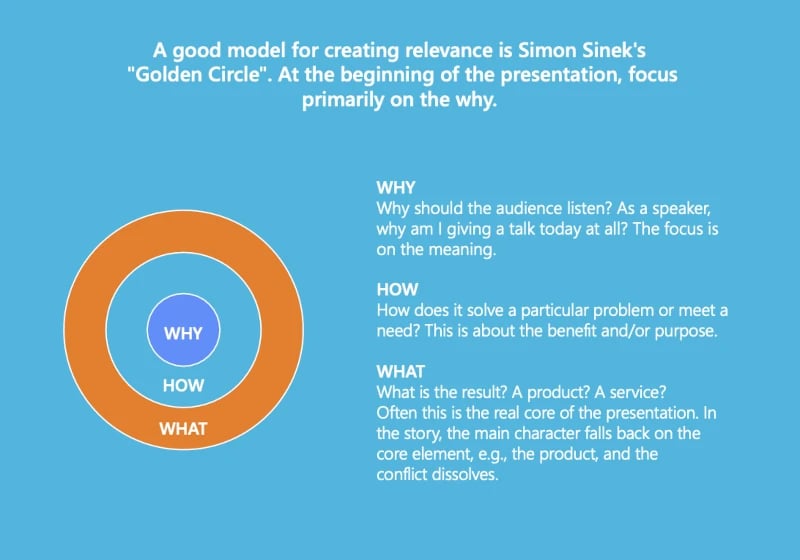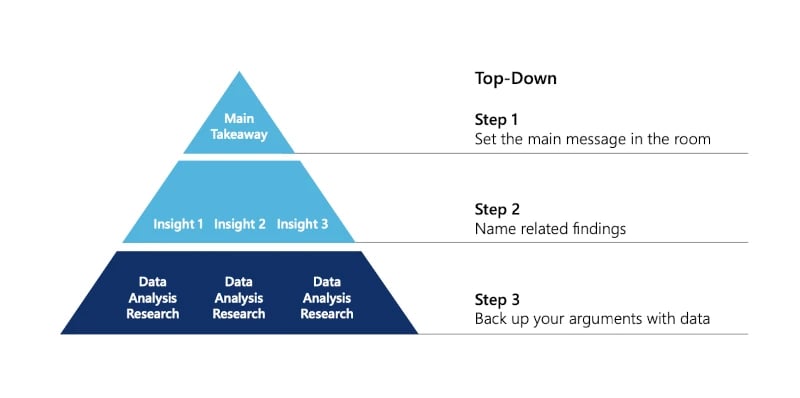Storytelling in presentations: How does it work?
Good stories evoke emotions and are an effective way to connect dry facts with emotions in the business world. Storytelling makes them tangible and understandable. The facts form the basis of a business story, whether in marketing, public relations, sales or other areas. The story itself serves as a vehicle.
In terms of story structure, it doesn't matter whether you're marketing a product, a company's assets, or an idea. The basic ingredients of a compelling business story are essentially the same:
Goal: What do you want to get out of telling this story?
Main character: It is the focus of the audience's attention. It must be easy for the audience to relate to. Possible main characters are products, employees, customers, founders/CEOs, or investors.
Conflict: Life is full of drama – and so is the story. The main character must resolve conflicts, make mistakes, and learn from them in the end.
End: The main character uses what he or she has learned to make a positive difference in his or her life and in the world around him or her.
But how do you use storytelling in presentations? How do you create an exciting beginning, a connecting middle and a motivating end? Ellen Riesterer, CEO of Folienwerke, sheds light on this topic. The presentation expert has some valuable tips and tricks up her sleeve.
Preparation
Analyzing your audience is one of the first steps in creating a powerful presentation. It does not have to be a doctoral dissertation. Three simple questions that can be answered in a few key words are enough.
Who is the audience?A brief collection of facts about each audience group's profession, age, living situation, education, etc. is sufficient here.
Why is the audience listening to the presentation?It is important to determine the audience's motivation, needs, and goals.
What resistance does the audience have?What prejudices, doubts, reservations, or fears might the audience have about the topic?
Beginning
The first few seconds determine the interest and attention of your audience. A successful introduction should make it clear that the presentation is worth listening to. What will the presentation change for the audience? What problem will be solved? The point is to create a foundation where the audience feels understood and engaged. Establish a context that allows for a personal connection to the main character of the story. Even with inherently exciting topics or important presentations, a boring introduction can have a negative impact on the audience's motivation and attention, sending them scurrying for their smartphones.

Offer proximity, benefit, or novelty, and you are sure to get attention. Practically speaking, this can be done as follows:
- Illustrate the problem with a real-life situation that the audience can relate to. Ideally, the story is based on, or at least inspired by, real-life experiences of the audience.
- Share a personal anecdote about the topic. Maybe a story where things did not go smoothly? This will make you seem more relatable and authentic. At best, the anecdote will illustrate why you, of all people, are on stage as a speaker.
- Get attention with provocative or unexpected questions. Let the audience answer or answer the question yourself.
- Provide interesting and current facts or statements. The more current the information, the more interesting it will be to the audience.
- Use a physical object as a lead-in to create a break from the digital media and stay in mind, e.g.: "Do you know what I am holding here and how this object relate to today's topic?"
- Or why not start with the end of the story? And in the form of a review.
End
What is the ultimate goal of your presentation? This should be made clear at the end. In addition to the solution or goal of the story, there should be a clear closing message or call to action. The ending determines what happens after the presentation. What do you want to achieve and what action should be taken? For example, give a clear call to action on how to reach the target situation.
Remember, a presentation has no purpose unless it creates change for the audience.
Ideas for closing your presentation:
- A pertinent, evocative closing statement
- A direct question to the audience, such as: "What will you do differently in the future?"
- A clear invitation to the next step
- A small task at the end so the audience can immediately apply what they have learned
Middle part
Once the beginning and end have been determined, you can start drafting the middle section. Here, the focus is on the conflict or hurdle that the main character must overcome. This means it's about the didactic structure of information, arguments, etc.
Start by brainstorming all relevant content. Cluster, filter, and prioritize all the ideas and make the connections to the beginning and end. This will create a common thread.
It is important to make clear statements that provide a direct path from beginning to end without detours. Avoid digressions! Omit the unimportant, especially if the time allotted for the presentation is short. Barbara Minto's pyramid principle can help: Start with the key message, followed by the rationale, and then, if at all, the underlying data and analysis.

Design
Once the story, including the beginning, end, and middle, has been established, it "only" needs to be put on paper. Storytelling in presentations primarily involves the use of visual elements that accompany and emotionalize the didactic structure of the presentation. Some examples:
Analogies/metaphors: Analogies and metaphors are very effective stylistic devices for presenting facts in a vivid way. The use of metaphors creates a memorable image of the message in the audience's mind that is easy to remember. In this way, your messages can be conveyed more effectively. You can also visualize metaphors, such as using a lock to represent data security or a piggy bank to represent cost savings.
Graphical elements: Even simple graphic elements serve a purpose. Give your main character a graphic element. This could be a Superman icon that symbolizes your clientele or an appropriate icon for your product. Storytelling gives these elements a deeper meaning and visually guides them through the presentation by reappearing and placing them in the right places.
Animations: Animations are also interesting because they can create additional meaning and support statements through the movement of elements. However, less is more. Use animations with care.
The morph effect is particularly effective. This is where two elements are superimposed, and the distortion creates an impressively realistic transition from the source image to the target image. This effect can be achieved with numbers, letters, images, and shapes.
Presenting numbers: If you look closely, there are often stories behind numbers that provide exciting points of entry. Connect abstract numbers and make them tangible.
A fictional but powerful example: A drug company's mission is to rid the world of cancer. Financial resources also play a role. With just two numbers, the company tells almost the whole story: The manufacturer has calculated that with NASA's budget, 5 effective anti-cancer drugs can be developed in 10 years.
Numbers can also be presented in exciting visual ways. PowerPoint charts that use symbols or filled shapes look more infographical and entertaining than traditional column or bar charts. Stay within the story and consider what motif lends itself to data visualization. Maybe filled in people for socio-demographic data, or stacks of shoe boxes of different heights to visualize sales of the new bestseller.
The basic rule: The basic rule is that slides presented to an audience should not distract from the presenter and his or her presentation. In plain English: little text, clear statements, visual elements. Slides used as handouts or documentation, on the other hand, must be self-explanatory and often require more text and explanation.
About Folienwerke
With Folienwerke, a consulting and design agency for presentations in Switzerland, Michael Bäuerle (founder) and Ellen Riesterer (CEO) have one goal: to enable communication between people in a given time frame with maximum results. To this end, Folienwerke offers individual consulting and training. With a focus on storytelling, presentation and rhetoric, speakers are guided to more successful presentations, inspired and encouraged to be authentic.

"Storytelling has the power to engage people. Concise stories take your audience on a journey they will never forget." - Ellen Riesterer
You May Also Like
Related articles

PowerPoint Trends 2022

Telemetry as a key to increase productivity: empower® data insights


